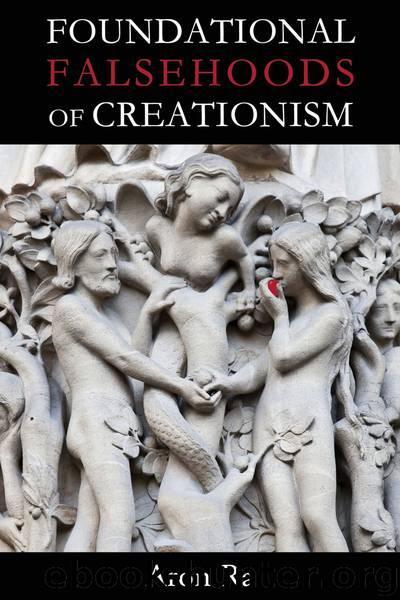Foundational Falsehoods of Creationism by Ra Aron

Author:Ra, Aron
Language: eng
Format: epub
Publisher: Pitchstone Publishing
Published: 2016-03-11T05:00:00+00:00
In 2005, a peer-reviewed scientific journal published results of the tests. It turns out that chromosome 2, which is unique to the human lineage of evolution, emerged as a result of the head-to-head fusion of two ancestral chromosomes that remain separate in other primates. Three genetic indicators provide strong, if not conclusive, evidence of fusion. First, the banding (or dye pattern) of human chromosome 2 closely matches that of two separate chromosomes found in apes (chimp chromosome 2 and an extra chromosome that does not match any other human chromosome). Second, a chromosome normally has one centromere, or central point at which a chromosome’s two identical strands are joined. Yet remnants of a second, presumably inactive centromere can be found on human chromosome 2. And third, whereas a normal chromosome has readily identifiable, repeating DNA sequences called telomeres at both ends, chromosome 2 also has telomere sequences not only at both ends but also in the middle.
Creationist apologists try to come up with whatever excuses they can to dismiss or discredit any examples of beneficial mutations discovered by science.
Yet, creationists don’t do their own experiments. Even when they publish their own journals, so they can pretend to be peer-reviewed, they still don’t take part in the scientific process, because there’s no way to falsify their findings and call their primary assumptions into question. They certainly can’t refute what has already been peer-reviewed, because even if a given peer-reviewed finding is later refuted, it would take science to do so. All that creationists can do when we cite peer-reviewed journals is to try to misrepresent what has been said. So I like to cite examples that refute their arguments very clearly. For instance, a February 10, 2010 research article, “Human and Non-Human Primate Genomes Share Hotspots of Positive Selection” by David Enard et al., published in the peer-reviewed Public Library Of Science Genetics, precisely defines and positively identifies beneficial mutations:
Download
This site does not store any files on its server. We only index and link to content provided by other sites. Please contact the content providers to delete copyright contents if any and email us, we'll remove relevant links or contents immediately.
The Lost Art of Listening by Michael P. Nichols(7388)
Why I Am Not A Calvinist by Dr. Peter S. Ruckman(4088)
The Rosicrucians by Christopher McIntosh(3455)
Wicca: a guide for the solitary practitioner by Scott Cunningham(3117)
Signature in the Cell: DNA and the Evidence for Intelligent Design by Stephen C. Meyer(3055)
Real Sex by Lauren F. Winner(2950)
The Holy Spirit by Billy Graham(2880)
To Light a Sacred Flame by Silver RavenWolf(2757)
The End of Faith by Sam Harris(2676)
The Gnostic Gospels by Pagels Elaine(2459)
Waking Up by Sam Harris(2380)
Nine Parts of Desire by Geraldine Brooks(2313)
Jesus by Paul Johnson(2294)
Devil, The by Almond Philip C(2266)
The God delusion by Richard Dawkins(2251)
Heavens on Earth by Michael Shermer(2225)
Kundalini by Gopi Krishna(2128)
Chosen by God by R. C. Sproul(2113)
The Nature of Consciousness by Rupert Spira(2034)
